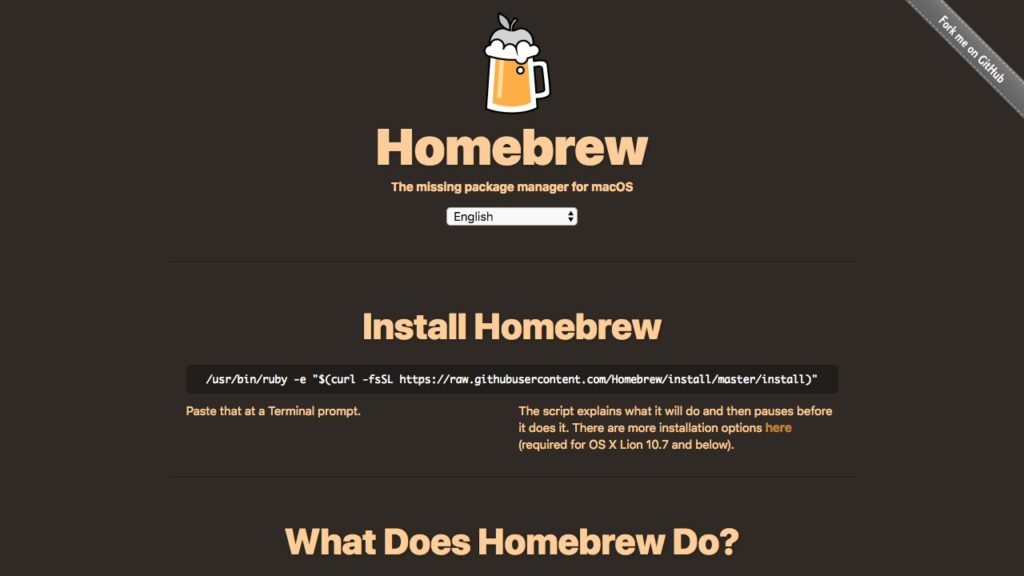
- #Homebrew for mac 10.13 how to
- #Homebrew for mac 10.13 mac os x
- #Homebrew for mac 10.13 install
- #Homebrew for mac 10.13 update
- #Homebrew for mac 10.13 license
#Homebrew for mac 10.13 install
The system will not install a JRE that has an earlier version than the current version. To sign up for an account, please click here or at the JOIN NOW link at the top right of this page.

#Homebrew for mac 10.13 how to
When you install the JRE, you can install only one JRE on your system at a time. This guide will show you how to connect to a StrongVPN WireGuard server on Mac OSX 10.11 - 10.13 using HomeBrew and W ireGuard-tools. To install an earlier version of the JRE, you must first uninstall the current version. To determine the current JRE version installed on your system, see Determining the JRE Version Installed on macOS. However, the system will not replace the current JRE with a lower version.

When you install the JDK, it also installs the JRE. Administrator privileges are required to install the JDK and JRE on macOS.
#Homebrew for mac 10.13 update
Running Brew’s update command instructs it to fetch the latest install recipes from its remote. Once Homebrew has finished installing, you’ll want to make sure to always run the following before trying to install anything using the brew command: brew update.

#Homebrew for mac 10.13 mac os x
Step-by-step reproduction instructions (by running brew commands) brew update after updating to 10.13. Install Homebrew on Mac OS X 10.7+ How to Install Homebrew on Mac OS X (10.7 or later) This one’s super-quick and easy. Installing the JDK and JRE on macOS is performed on a systemwide basis for all users. You should change the ownership and permissions of /usr/local back to your user account: sudo chown -R (whoami) /usr/local. You cannot install Java for a single user. download cacert.pem from and copy it to /usr/local/etc/openssl/cert.The following are the system requirements for installing the JDK and the JRE on macOS: MariaDB Server is available as a Homebrew. In Terminal, you can run any process with Rosetta by prefixing it with arch -x8664. And with that installed, we have Homebrew up and running and we can start using the architecture flag for our installations. This lets you run Intel things with a little overhead. Grav: macOS 10.13 High Sierra Apache Setup: Upgrading Homebrew. MariaDB Server is available for installation on macOS (formerly Mac OS X) via the Homebrew package manager. Homebrew can work just fine with Rosetta 2 and some things work natively.
#Homebrew for mac 10.13 license
Some great work by the Homebrew team Some great work by the Homebrew team Now that Apple opened up the beta program for their Desktop OS to everyone (not requiring a developer license anymore) a lot of people will be upgrading to OS X 10. In the terminal, run the following command to install Xcode command line tools: xcode-select -install. Note the file that fails to download, i.e. In other words, it is no longer needed to make changes to your Homebrew install manually. From the Finder, select Go and click Utilities to display all the utilities.So you'll need to follow up by installing the homebrew version of curl. You'll probably still need xcode installed, and use the steps in Brad Bell's answer to use it to install curl.Īnother option (untested) might be to install xcode, then build curl locally from source (ex: download with a browser, unzip it, build as normal to some temp location), put that location's bin folder first in your PATH, then run the normal homebrew installation instructions.Īfter installing Homebrew using the above steps, you still may not be able to install anything with it, because it wants to download packages using the same outdated version of curl.

replace /usr/bin/curl -#/tarball/master with cat ~/Downloads/ If so, just run install.packages ('RGtk2', depenT, type'source.


 0 kommentar(er)
0 kommentar(er)
